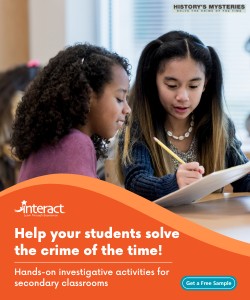
As President Obama’s powerful quote implies, geography is a foundation for students to understand the world. It not only helps them consider their place in the world and their connection to others, but it also helps them recognize the tapestry of historical communities and cultures from around the world. How can we teach students the breadth of how geography affects them and the consequences of not understanding it fully?
National social studies standards help guide students through geographic and civic literacy. Ideally, by the time students complete their senior year in high school they have an in-depth understanding of comparative histories, government, and economics; the ability to decipher bias in text; among many other foundational skills. At the root of all these skills is geography.
Geography affects every aspect of our daily lives, from the food we eat and the climate we live in to the opportunities we have in our lives. Teachers spend time fostering lifelong critical thinkers and learners, not only in the history classroom, but in all subject areas. As students prepare to graduate and enter the adult world, a natural question is “what are the applications of geography after students leave K-12 and how can we continue to help them comprehend the world around them?” The classroom will build the foundation, but students must combine their critical-thinking skills and learned geography to their ongoing understanding of their world. Here are a few examples of how geography can affect students’ lives, and ways teachers can incorporate these themes in the classroom.

Thomas Friedman, Pulitzer Prize-winning journalist, is best known for outlining how the internet has made us globally connected with an abundance of new economic opportunities spanning across the globe. Even though we are deeply immersed in the information age, the bulk of world commerce still lies in the trade of materials. For our students to comprehend economic trade, they must understand place, trade routes, and the intersection of nature along the pathways of human travel. A keen sense of geography will help students understand where materials come from. Incorporating themes of globalization and economics in social studies curricula will help students better grasp how interconnected the world is. As they enter the work force or travel to a different country, this understanding will be crucial.
Gillian Coote Martin’s article, “The Effects of Cultural Diversity in the Workplace,” states that “cultural diversity can affect the workplace in numerous ways. Negative effects can include miscommunication, creation of barriers, and dysfunctional adaptation behaviors. Positive effects can include building a sound knowledge base with in-house talent, which can make for smoother integration of the organization into foreign cultures.” After they graduate, students will have to navigate living and working in a diverse world when they attend college or begin working. They will have to learn how to effectively communicate, respect other cultures, and honor different ways of looking at the world. By understanding geography, these future world citizens will have a frame of reference to understand the people that they share their lives with. We best know a person when we understand that person’s story. Understanding geography opens the door for that personal connection.

With ongoing discussions of climate change, students should deepen their understanding of geography to fully understand the challenges of living in a constantly adapting natural environment. Many people are already aware of “the butterfly effect” on weather, but climate changes in one region of the world can have profound effects on world trade or social movements. Students need to understand how their own choices can lead to a butterfly effect in their immediate world. By applying a detailed understanding of geography, students can build a sense of place and how humans affect and can be affected by nature. Give your students the opportunity to research waste in different countries and its effect on nature, or visit a recycling facility to help them grasp real-world applications of their actions.

Social improvement is dependent on how well we can connect with others. Since no one is an island, we need a comprehension of geography to understand human stories. Students need to know how the human impact on geography to understand where the world has been and where it is going. This will set a foundation for them to begin to know how to make their world better. Enriching students’ understanding of the history of geographical change directly informs their actions after leaving school. Specifically, students can look to the historical impact of civil engineering projects to inform their own leadership opportunities in their own communities.
Most importantly, fostering geographic understanding helps students understand their own stories. We know ourselves by knowing where we come from. To truly help our students understand themselves, they need to learn the history of their own communities. As they interact with the world around them, students should use their understanding of geography to learn the plethora of stories from around the world. Family genealogy or ancestry projects are a great place to begin for students to learn their own familial histories. However, teachers can adapt any historical research project to compare and contrast their own lives to those of others.
How do you think geography affects our lives? We would love to hear from you.
Ken Klieman is the author of Building an Empathy-Based Classroom, and he has taught over 5,500 students and trained over 3,000 teachers. Ken has been awarded both California Teacher of the Year and Comcast All-Star Teacher of the Year. His work as a leading teacher trainer for the NEA and CTA and keynote speaker have solidified his pedagogical approach focusing on community building through performance-based, student-inquiry projects.
References
Martin, Gillian Coote. “The Effects of Cultural Diversity in the Workplace.” Journal of Diversity Management (JDM), vol. 9, no. 2, 2014, p. 89., doi:10.19030/jdm.v9i2.8974.
Posted in Blog Tagged Curriculum & Instruction, Geography